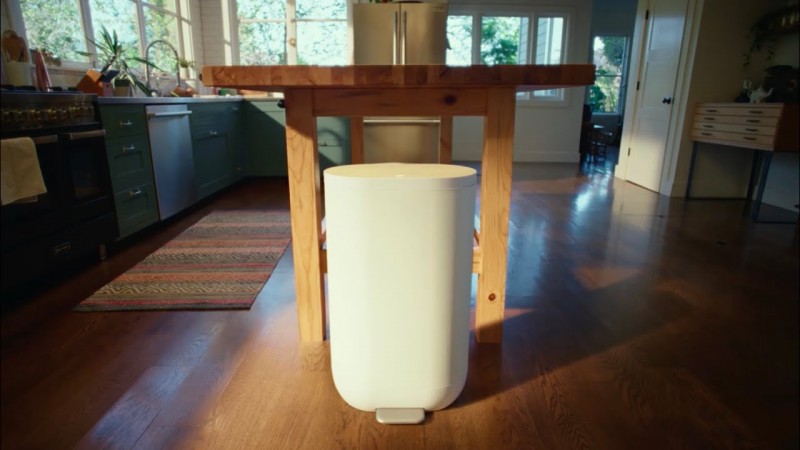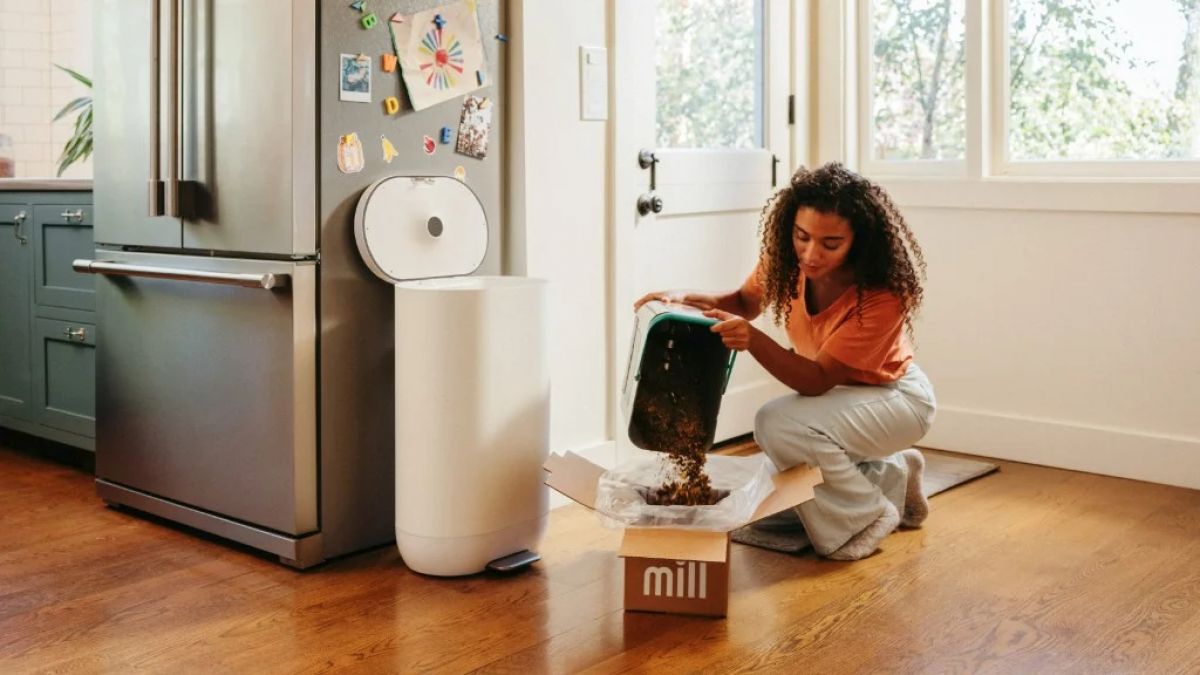
New Delhi:- Giving leftovers to chickens is not a new idea. But on the other hand, smoke detectors were also not well-liked or popular when Matt Rogers started Nest in 2010. However, his idea was successful. Rogers is doing something again, but this time he is with Harry Tannenbaum who also used to work at Nest. The Mill team has created a very heavy, expensive, and advanced kitchen waste bin.
Mill wants to stop the release of carbon into the air when food waste breaks down. The startup is not the first company to try solving the problem, but it has a different and special way of doing it. Most companies focus on big places like grocery stores or restaurants, but Mill focuses on people's homes. The bin crushes and dries food, and the company picks it up in the United States. The Postal Service sells the leftover packages to farmers to use as food for their chickens. This company is very smart in the way they manage resources and waste.
A while ago, Mill gave me a machine to try out. I used it to put in leftovers, fruit peels, corn cobs, and anything else that was mentioned in the list of food scraps it claimed it could handle. I wanted to see if the Mill bin could be used in our daily routine to help reduce the negative effects on the environment caused by our waste.
Also Read:- Nothing to have CMF concur in by BIS with fair price in India
The quick answer is that it mostly worked, but there were some problems along the way. The bin and everything you need to use it are free when you subscribe. The subscription costs $495 a year or $45 a month. However, if you choose the monthly plan, there is an additional $75 fee to have the bin delivered to you. We will provide boxes for shipping and cover the cost of returning them as well.
Mill's bin is a well-designed bin for putting kitchen waste. The sides are a plain white color, the foot pedal that opens the lid is gray, and the lid has a fake blond wood design with some clever hidden technology inside (more information about that will be explained later). There is a button on the cover that you can press to turn on or off the lock for kids or pets. There is a big charcoal filter hidden at the bottom of the back.
Pressing on the foot pedal makes a motor move the lid and open it. The inside of the room is smaller than it looks from the outside. A large metal bucket sits inside, and there are some augers inside the bucket that crush the food waste into small pieces. The machine looks similar to a large bread maker.
At the end of each day, the bin checks how much new stuff was added and starts doing its job. The time when something begins is selected using a user-friendly app. It also wants you to give a name to the bin (I called ours "Munchie"). Our kitchen doesn't have a space near a wall plug for the trash can, so we kept it in the family room, just around the corner. I scheduled the grinder to start at 10:30 p. m because that's when we watch TV.
Also Read:- Amazon Sale to have TWS Earphones at a bear market rates
When that time comes, the bin locks with a sudden and loud click, and then starts making a grinding noise. Depending on what you put in, the process can either be quiet or make a loud noise like an old ship. Sometimes, a machine that blows hot air is used to dry out the leftover bits.
You can see how far you've come by looking at the app or by looking at the lights on the faux wood top. It's a smart gadget that informs you when the lid is closed, when the augers are working, or when the heaters are drying the coffee.
In perfect situations, everything is finished before you wake up to eat breakfast. In most situations, I would agree that it is accurate. You can open the app whenever you want to see how much longer the grinding and drying will take. Usually, it's correct. Sometimes, it is not.
One night, I believe I filled the bin completely. I put a lot of stuff in it, like apple skins, an apple middle, egg shells, food from the table, and a whole cantaloupe that smelled really bad. I cut the melon into pieces like the app recommended. At 10:30 p. m, they told me it would take around seven to nine hours to finish the whole process. In the morning at 7:30. The next day, it said it would take an additional hour and 45 minutes. At twelve o'clock, the guess had stayed the same. By 3:30 p. m, the estimated time left increased to 2 hours and 10 minutes. At last, it ended at 6 p. m, which was 19. 5 hours after it began.
Also Read:- Amazon Sale to have huge Affordabilities on ANC Ear and Headphones
This had happened before when it misjudged how long it would take. It's not a big problem because you can just double-click the button on the lid to stop the process and add more leftovers. However, the fan was constantly running, both during the day and night. It is not very noisy, but it is also not very silent.

If the bin is full, it will let you know on your phone. To empty the bin, all you have to do is open the lid, use the handle to lift the bucket out, and pour the coffee grounds into the plastic bag that comes with it. The areas are able to be stored for a long time without spoiling. I thought our smell was nice, like soy sauce. When the bag is completely filled, place it inside a marked box that is already provided. The boxes already have sticky parts on the flaps, so you don't have to use tape to close them. (For some reason, I really liked that.) When you're ready, just let the app know and it will arrange for the USPS to come and pick it up the following day. In the morning, I placed the box on the front porch. Later that day, the mail carrier took it away.
Overall, the process went well, except for one important thing. I woke up on the morning of Father's Day and saw a flickering light on the cover. The tools were stuck, but it wasn't clear why right away. I was feeling lazy, so I left the bucket in the bin and spent about 20 minutes trying to make things easier. No success.
Also Read:- Killer Instinct to get revolutionary with Xbox X upgraded together
The next day, I did what the app told me to do. I took the bucket and poured the loose coffee grounds into the mail bag. When I first looked, I saw that some of the dirt was stuck to the side of the bucket. I thought this was the reason and started working on it with some chopsticks that can be thrown away. Later on, my father-in-law mentioned that the jam might be caused by tiny threads getting tangled in the augers. So, I removed as many of the threads as possible. After 20 minutes of chipping and pulling forcefully, the augers were no longer stuck.
Also Read:- Apple products have great drops on some hand picks
After the traffic, Mill said there were a few possible reasons. The team made changes to the app's instructions about what people should and should not throw in the bin because fibrous material was causing more problems than they thought. Corn husks were taken off the list of allowed items, like something we hadn't included. Putting a lot of sugary scraps into a bin that was already almost full was also causing problems and blockages. Lastly, the company has improved the software that controls how long and how hot something is during a process. They have managed to make the cycle time an hour shorter on average.
"Currently, we prefer to be cautious to prevent any unpleasant odors or risk of bacteria," said Suzy Sammons from Mill. The software improves over time as we gather more information from customers and trials. It becomes better at predicting how long it takes for a cycle to complete and the amount of heat needed in the bin, which reduces the chance of a blockage. The company also monitors the bins from a distance and helps customers troubleshoot if they encounter a blockage. Software updates have decreased the likelihood of a blockage by at least 50%. Also, if any of the separate parts are damaged, Mill will provide a replacement at no cost.
Also Read:- Ghoomer Trailer Out: A Tale of an Inspirational Sports Drama!
Matt Rogers, the creator of Nest, started a new company. He was doing really well with his startup. Now, he is working on a problem: finding a way to break down regular garbage, all the way from food waste to chicken bones, inside the trash bin. This makes the bin the fanciest and most costly bin ever created. But now the question is, will it go directly into the Kitchen. It is expensive and needs to be used with caution.